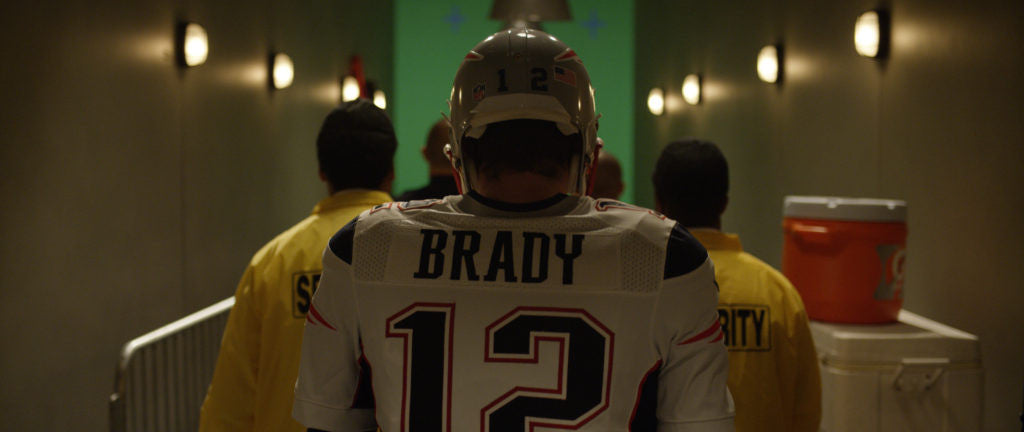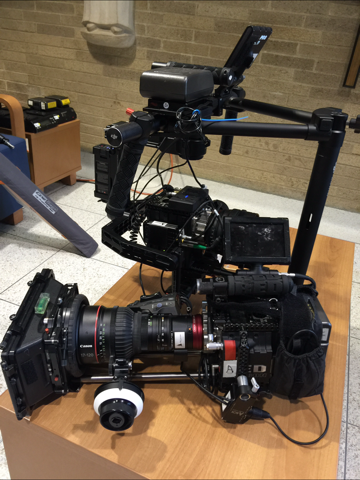
"The Greatest” opened Fox’s coverage to this year’s Super Bowl broadcast. It was produced by the highly acclaimed DLP Media Group {Exec Producers: Michael Hughes/Greg Lake; Producer: Matt Schlef; Director: Todd Kapostasy; Editor: Jason Sanchez; DP: Jonathan Belinski}.
The piece takes the viewer through the journey of Muhammad Ali on his quest to become the greatest fighter of all time and then interweaves that same analogy to the greatest NFL players of the past several years, culminating in Tom Brady’s quest to become “The Greatest”. Director Todd Kapostasy’s tautly written script ties the story together, which was voiced by actor Anthony Mackie (Avengers, Captain America, The Hurt Locker).
Shot over a span of three days on a soundstage in Los Angeles, no attention to detail was spared by the production team. Producer Matt Schlef’s keen eye saw to it that actors were coordinated with various practical lighting elements such as period accurate flash photography, film cameras, and era accurate wardrobe, including casting actors with similar size and build to portray the various athletes. This was no small task. The sets were built practically by Art Director Johnny Chou with slight variations made between the scenes to match the backgrounds of the time.
A roughly 60-foot tunnel was created that was able to change width, height, and orientation to accommodate different looks. At the back end of the tunnel was a large-scale green screen where images appropriate to the era were comped in later with tracking marks as guides by Chicken Bone Post Production. Final color correction was done by Bryan Smaller from Company 3, a high-end color house noted for it’s work on big budget feature films.


Images were captured in 6k resolution widescreen format on Red Dragon cameras with high-end Leica PL mount cine primes for the ultimate cinematic experience. The cameras were also equipped with Teradek Bolt 300 wireless video systems for ultimate mobility. Almost every shot was moving with a Ronin Gimbal system or a MYT Works Large Glide operated by DP Jonathan Belinski to create the sense of always moving forward toward the end of the tunnel. Of particular challenge was the extreme height of the players (some of them over 6’5″), and for most shots, the camera department discovered just muscling the gimbal system overhead provided better results than using traditional support systems.
"Teradek was once a luxury for us on set but has since become a staple tool as integral as any other piece of equipment. We use various models on all of our camera systems as a matter of course. Clients, Directors, Focus Pullers, art department, hair, and makeup all rely on an uninterrupted video feed in modern production. It also frees up the camera operators to utilize today's most advanced motion tools without worrying about tripping over cables or affecting balance of a Steadicam or gimbal System. I can't imagine ever going back to plugging in straight to a monitor" says Jonathan Belinski, Director of Photography.


Lighting the set was a particularly unique challenge, as the wall dimensions were constantly changing to give different looks. A plan was devised largely using 6k spacelights in a row on a crank system that could raise and lower their height. Additional baffling and diffusion frames were added to change the quality and intensity of light between scenes, while still having the ability to control spill light on the walls to the overall quality that was envisioned. Many additional units were employed by gaffer Chris Andrus to highlight background extras and heighten the drama of the scenes while still maintaining a natural, believable look.

A particularly pivotal moment in the piece was Muhammad Ali’s refusal to enter the Vietnam draft. This represented a departure in scenery from the tunnel set, but EP Michael Hughes discovered a hallway location nearby that served our purposes well. The lighting and art team had to improvise quickly and utilize the now practical location for maximum effect. Doors were removed from hinges, lights were bounced off floors, and set pieces were moved in to make the background more organic and authentic. This entire scene was captured in camera with no post FX.


Post Production was overseen by the watchful eye of Editor Jason Sanchez who deftly interwove historical footage with modern elements. Sound Designer Jim Mitchell created Sound FX that heightened the atmosphere completing Director Todd Kapostasy’s vision.
This set was filled with a tremendous amount of Emmy winners and accomplished talent who collectively had a singular goal to make the piece as good as it could be. The results speak for themselves. Easily one of the best projects Belinski Media has ever been involved in.
- Jonathan Belinski is Owner and DP at Belinski Media, a high-end production company based in New York and Los Angeles.
